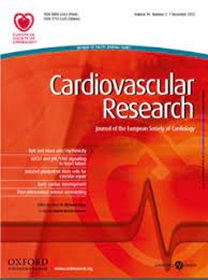miR-24-3p secreted as extracellular vesicle cargo by cardiomyocytes inhibits fibrosis in human cardiac microtissues
IF 10.2
1区 医学
Q1 CARDIAC & CARDIOVASCULAR SYSTEMS
引用次数: 0
Abstract
Background and Aims Cardiac fibrosis in response to injury leads to myocardial stiffness and heart failure. At the cellular level, fibrosis is triggered by the conversion of cardiac fibroblasts (CF) into extracellular matrix–producing myofibroblasts. miR-24-3p regulates this process in animal models. Here, we investigated whether miR-24-3p plays similar roles in human models. Methods and Results Gain– and loss–of–function experiments were performed using human induced pluripotent stem cell–derived cardiomyocytes (hCM) and primary hCF under normoxic or ischaemia–simulating conditions. hCM–derived extracellular vesicles (EVs) were added to hCF. Similar experiments were performed using three-dimensional human cardiac microtissues and ex vivo–cultured human cardiac slices. hCF transfection with miR-24-3p mimic prevented TGFβ1–mediated induction of FURIN, CCND1 and SMAD4—miR-24-3p target genes participating in TGFβ1–dependent fibrinogenesis —, regulating hCF–to–myofibroblast conversion. hCM secreted miR-24-3p as EV cargo. hCM–derived EVs modulated hCF activation. Ischaemia–simulating conditions induced miR-24-3p depletion in hCM-EVs and microtissues. Similarly, hypoxia downregulated miR-24-3p in cardiac slices. Analyses of clinical samples revealed decreased miR-24-3p levels in circulating EVs in acute myocardial infarction (AMI) patients, compared with healthy subjects. Post-mortem RNAScope analysis showed miR-24-3p downregulation in myocardium from AMI patients, compared with patients who died from noncardiac diseases. Berberin, a plant–derived agent with miR-24-3p–stimulatory activity, increased miR-24-3p contents in hCM-EVs, downregulated FURIN, CCND1 and SMAD4, and inhibited fibrosis in cardiac microtissues. Conclusions These findings suggest that hCM may control hCF activation through miR-24-3p secreted as EV cargo. Ischaemia impairs this mechanism, favouring fibrosis.心肌细胞作为细胞外囊泡货物分泌的 miR-24-3p 可抑制人类心脏微组织的纤维化
背景和目的 心肌纤维化会导致心肌僵硬和心力衰竭。在细胞水平上,纤维化是由心脏成纤维细胞(CF)转化为产生细胞外基质的肌成纤维细胞引发的。在此,我们研究了 miR-24-3p 是否在人体模型中发挥类似作用。方法与结果 在常氧或缺血模拟条件下,使用人诱导多能干细胞衍生的心肌细胞(hCM)和原代 hCF 进行了功能增益和功能缺失实验。用 miR-24-3p mimic 转染 hCF 可阻止 TGFβ1 介导的 FURIN、CCND1 和 SMAD4(参与 TGFβ1 依赖性纤维蛋白生成的 miR-24-3p 靶基因)的诱导,从而调节 hCF 向肌成纤维细胞的转化。缺血模拟条件诱导了 hCM-EVs 和微组织中 miR-24-3p 的耗竭。同样,缺氧也会下调心脏切片中的 miR-24-3p。对临床样本的分析表明,与健康人相比,急性心肌梗死(AMI)患者循环EV中的miR-24-3p水平降低了。死后 RNAScope 分析显示,与死于非心脏病的患者相比,急性心肌梗塞患者心肌中的 miR-24-3p 下调了。具有 miR-24-3p 刺激活性的植物源制剂小檗碱增加了 hCM-EVs 中的 miR-24-3p 含量,下调了 FURIN、CCND1 和 SMAD4,并抑制了心脏微组织的纤维化。结论 这些研究结果表明,hCM 可能通过作为 EV 货物分泌的 miR-24-3p 来控制 hCF 的激活。缺血损害了这一机制,有利于纤维化。
本文章由计算机程序翻译,如有差异,请以英文原文为准。
求助全文
约1分钟内获得全文
求助全文
来源期刊

Cardiovascular Research
医学-心血管系统
CiteScore
21.50
自引率
3.70%
发文量
547
审稿时长
1 months
期刊介绍:
Cardiovascular Research
Journal Overview:
International journal of the European Society of Cardiology
Focuses on basic and translational research in cardiology and cardiovascular biology
Aims to enhance insight into cardiovascular disease mechanisms and innovation prospects
Submission Criteria:
Welcomes papers covering molecular, sub-cellular, cellular, organ, and organism levels
Accepts clinical proof-of-concept and translational studies
Manuscripts expected to provide significant contribution to cardiovascular biology and diseases
 求助内容:
求助内容: 应助结果提醒方式:
应助结果提醒方式:


